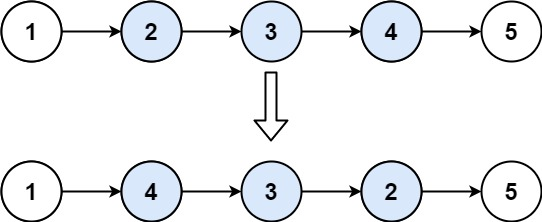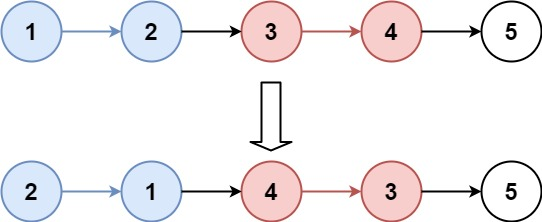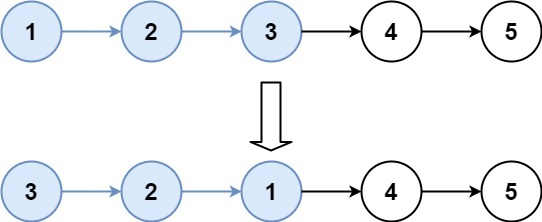剑指 offer 第 2 天
第 2 天
链表(简单)
剑指 Offer 06. 从尾到头打印链表
输入一个链表的头节点,从尾到头反过来返回每个节点的值(用数组返回)。
示例 1:
输入:head = [1,3,2]
输出:[2,3,1]
限制:
0 <= 链表长度 <= 10000
题解思路:辅助栈、反向填充、递归
辅助栈:利用栈先进后出的性质,实现反向节点
/**
* Definition for singly-linked list.
* public class ListNode {
* int val;
* ListNode next;
* ListNode(int x) { val = x; }
* }
*/
class Solution {
public int[] reversePrint(ListNode head) {
Stack<ListNode> stack = new Stack<ListNode>();
ListNode temp = head;
while (temp != null) {
stack.push(temp);
temp = temp.next;
}
int size = stack.size();
int[] print = new int[size];
for (int i = 0; i < size; i++) {
print[i] = stack.pop().val;
}
return print;
}
}
反向填充:反向填充数组下标
/**
* Definition for singly-linked list.
* public class ListNode {
* int val;
* ListNode next;
* ListNode(int x) { val = x; }
* }
*/
class Solution {
public int[] reversePrint(ListNode head) {
ListNode currNode = head;
int len = 0;
while (currNode != null) {
len ++;
currNode = currNode.next;
}
int[] print = new int[len];
for (int i = len-1; i >= 0; i --) {
print[i] = head.val;
head = head.next;
}
return print;
}
}
递归:利用递归走到链表最后结点
/**
* Definition for singly-linked list.
* public class ListNode {
* int val;
* ListNode next;
* ListNode(int x) { val = x; }
* }
*/
class Solution {
public int[] reversePrint(ListNode head) {
ArrayList<Integer> tmp = new ArrayList<Integer>();
recur(head, tmp);
int[] res = new int[tmp.size()];
for(int i = 0; i < res.length; i++)
res[i] = tmp.get(i);
return res;
}
void recur(ListNode head, ArrayList<Integer> tmp) {
if(head == null) return;
recur(head.next, tmp);
tmp.add(head.val);
}
}
剑指 Offer 24. 反转链表
定义一个函数,输入一个链表的头节点,反转该链表并输出反转后链表的头节点。
示例:
输入: 1->2->3->4->5->NULL
输出: 5->4->3->2->1->NULL
限制:
0 <= 节点个数 <= 5000
题解思路:辅助栈、递归、迭代
辅助栈:利用栈结构先进后出的特点反转链表
/**
* Definition for singly-linked list.
* public class ListNode {
* int val;
* ListNode next;
* ListNode(int x) { val = x; }
* }
*/
class Solution {
public ListNode reverseList(ListNode head) {
if (head == null) {
return head;
}
ListNode curr = head;
Stack<ListNode> stack = new Stack<>();
while (curr != null) {
stack.push(curr);
curr = curr.next;
}
ListNode listNode = stack.pop();
ListNode res = listNode;
while (!stack.isEmpty()) {
listNode.next = stack.pop();
listNode = listNode.next;
listNode.next = null;
}
return res;
}
}
递归:通过递归利用系统栈反转链表,递归到最后一个节点中止,途中完成 head.next.next = head 的交换
/**
* Definition for singly-linked list.
* public class ListNode {
* int val;
* ListNode next;
* ListNode(int x) { val = x; }
* }
*/
class Solution {
public ListNode reverseList(ListNode head) {
if (head == null || head.next == null) {
return head;
}
ListNode newHead = reverseList(head.next);
head.next.next = head;
head.next = null;
return newHead;
}
}
迭代:通过头插法再次重建链表
/**
* Definition for singly-linked list.
* public class ListNode {
* int val;
* ListNode next;
* ListNode(int x) { val = x; }
* }
*/
class Solution {
public ListNode reverseList(ListNode head) {
ListNode prev = null;
ListNode curr = head;
while (curr != null) {
// 暂存后续节点
ListNode next = curr.next;
// 修改节点指向
curr.next = prev;
// 暂存当前头节点
prev = curr;
// 访问下一个节点
curr = next;
}
return prev;
}
}
反转链表的题目不止于此,目前常考察的还有区间反转、多次区间反转等
92. 反转链表 II
给你单链表的头指针 head 和两个整数 left 和 right ,其中 left <= right 。请你反转从位置 left 到位置 right 的链表节点,返回 反转后的链表 。
示例 1:

输入:head = [1,2,3,4,5], left = 2, right = 4
输出:[1,4,3,2,5]
示例 2:
输入:head = [5], left = 1, right = 1
输出:[5]
提示:
- 链表中节点数目为
n 1 <= n <= 500-500 <= Node.val <= 5001 <= left <= right <= n
进阶: 你可以使用一趟扫描完成反转吗?
题解思路:两次遍历、一次遍历
两次遍历:先断链,然后反转中间部分,再接上链表
/**
* Definition for singly-linked list.
* public class ListNode {
* int val;
* ListNode next;
* ListNode() {}
* ListNode(int val) { this.val = val; }
* ListNode(int val, ListNode next) { this.val = val; this.next = next; }
* }
*/
class Solution {
public ListNode reverseBetween(ListNode head, int left, int right) {
// 使用额外头节点
ListNode dummyNode = new ListNode(-1);
dummyNode.next = head;
ListNode pre = dummyNode;
// 得到left的前一个节点
for (int i = 0; i < left-1; i ++) {
pre = pre.next;
}
// 得到right节点
ListNode rightNode = pre;
for (int i = 0; i < right-left+1; i ++) {
rightNode = rightNode.next;
}
// 截断链表
ListNode leftNode = pre.next;
// 保存rightNode后续节点
ListNode curr = rightNode.next;
// 截断链接
pre.next = null;
rightNode.next = null;
// 反转链表
reverseLinkedList(leftNode);
// 恢复连接
pre.next = rightNode;
leftNode.next = curr;
return dummyNode.next;
}
// 反转链表
private void reverseLinkedList(ListNode head) {
ListNode curr = head;
ListNode pre = null;
while (curr != null) {
ListNode next = curr.next;
curr.next = pre;
pre = curr;
curr = next;
}
}
}
复杂度: 时间 O(n) 空间 O(1)
一次遍历:头插法建立链表的方式完成反转
/**
* Definition for singly-linked list.
* public class ListNode {
* int val;
* ListNode next;
* ListNode() {}
* ListNode(int val) { this.val = val; }
* ListNode(int val, ListNode next) { this.val = val; this.next = next; }
* }
*/
class Solution {
public ListNode reverseBetween(ListNode head, int left, int right) {
ListNode dummyNode = new ListNode(-1);
dummyNode.next = head;
ListNode pre = dummyNode;
for (int i = 0; i < left - 1; i ++) {
pre = pre.next;
}
ListNode curr = pre.next;
// 步骤记熟即可
for (int i = 0; i < right-left; i ++) {
// 保存后续节点
ListNode next = curr.next;
// 改变当前节点指向
curr.next = next.next;
// 改变next节点指向
next.next = pre.next;
// 改变pre节点指向
pre.next = next;
}
return dummyNode.next;
}
}
复杂度: 时间 O(n) 空间 O(1)
25. K 个一组翻转链表
给你一个链表,每 k 个节点一组进行翻转,请你返回翻转后的链表。
k 是一个正整数,它的值小于或等于链表的长度。
如果节点总数不是 k 的整数倍,那么请将最后剩余的节点保持原有顺序。
进阶:
- 你可以设计一个只使用常数额外空间的算法来解决此问题吗?
- 你不能只是单纯的改变节点内部的值,而是需要实际进行节点交换。
示例 1:

输入:head = [1,2,3,4,5], k = 2
输出:[2,1,4,3,5]
示例 2:

输入:head = [1,2,3,4,5], k = 3
输出:[3,2,1,4,5]
示例 3:
输入:head = [1,2,3,4,5], k = 1
输出:[1,2,3,4,5]
示例 4:
输入:head = [1], k = 1
输出:[1]
提示:
- 列表中节点的数量在范围
sz内 1 <= sz <= 50000 <= Node.val <= 10001 <= k <= sz
题解思路:多次区间反转
多次区间反转:
/**
* Definition for singly-linked list.
* public class ListNode {
* int val;
* ListNode next;
* ListNode() {}
* ListNode(int val) { this.val = val; }
* ListNode(int val, ListNode next) { this.val = val; this.next = next; }
* }
*/
class Solution {
public ListNode reverseKGroup(ListNode head, int k) {
ListNode dummyNode = new ListNode(-1);
dummyNode.next = head;
// pre 代表待翻转链表的前驱
ListNode pre = dummyNode;
// end 代表待翻转链表的末尾
ListNode end = dummyNode;
while (end.next != null) {
for (int i = 0; i < k && end != null; i ++) {
end = end.next;
}
if (end == null) {
break;
}
// 区间反转类似,保存反转前节点,反转后接上
ListNode start = pre.next;
ListNode next = end.next;
end.next = null;
pre.next = reverse(start);
start.next = next;
pre = start;
end = pre;
}
return dummyNode.next;
}
private ListNode reverse(ListNode head) {
ListNode pre = null;
ListNode curr = head;
while (curr != null) {
ListNode next = curr.next;
curr.next = pre;
pre = curr;
curr = next;
}
return pre;
}
}
复杂度:时间 O(n) 空间 O(1)
剑指 Offer 35. 复杂链表的复制
请实现 copyRandomList 函数,复制一个复杂链表。在复杂链表中,每个节点除了有一个 next 指针指向下一个节点,还有一个 random 指针指向链表中的任意节点或者 null。
示例 1:

输入:head = [[7,null],[13,0],[11,4],[10,2],[1,0]]
输出:[[7,null],[13,0],[11,4],[10,2],[1,0]]
示例 2:

输入:head = [[1,1],[2,1]]
输出:[[1,1],[2,1]]
示例 3:

输入:head = [[3,null],[3,0],[3,null]]
输出:[[3,null],[3,0],[3,null]]
示例 4:
输入:head = []
输出:[]
解释:给定的链表为空(空指针),因此返回 null。
提示:
-10000 <= Node.val <= 10000Node.random为空(null)或指向链表中的节点。- 节点数目不超过 1000 。
解题思路:哈希表复制、节点拆分
哈希表复制:利用HashMap先存储一次全部节点,再将其取出重建链表即可
/*
// Definition for a Node.
class Node {
int val;
Node next;
Node random;
public Node(int val) {
this.val = val;
this.next = null;
this.random = null;
}
}
*/
class Solution {
public Node copyRandomList(Node head) {
if (head == null) {
return head;
}
// key存放原节点,value存放待复制节点
Map<Node, Node> map = new HashMap<>();
// 节点复制val
for (Node cur = head; cur != null; cur = cur.next) {
map.put(cur, new Node(cur.val));
}
// 遍历链表,利用key中原节点信息填充value节点中的next和random
for (Node cur = head; cur != null; cur = cur.next) {
// 取出并赋值
map.get(cur).next = map.get(cur.next);
map.get(cur).random = map.get(cur.random);
}
return map.get(head);
}
}
复杂度:时间 O(n) 空间 O(n)
节点拆分:在每个节点相邻位置创建一个相同节点,先复制 next 和 val 域,再遍历一次复制random域,最后拆分两条链表
/*
// Definition for a Node.
class Node {
int val;
Node next;
Node random;
public Node(int val) {
this.val = val;
this.next = null;
this.random = null;
}
}
*/
class Solution {
public Node copyRandomList(Node head) {
if (head == null) {
return null;
}
Node cur = head;
// 1. 复制各节点,并构建拼接链表
while(cur != null) {
Node tmp = new Node(cur.val);
tmp.next = cur.next;
cur.next = tmp;
cur = tmp.next;
}
// 2. 构建各新节点的 random 指向
cur = head;
while(cur != null) {
if(cur.random != null)
cur.next.random = cur.random.next;
cur = cur.next.next;
}
// 3. 拆分两链表
cur = head.next;
Node pre = head, res = head.next;
while(cur.next != null) {
pre.next = pre.next.next;
cur.next = cur.next.next;
pre = pre.next;
cur = cur.next;
}
pre.next = null; // 单独处理原链表尾节点
return res; // 返回新链表头节点
}
}
复杂度:时间 O(n) 空间 O(1)
剑指 offer 第 2 天的更多相关文章
- 剑指Offer面试题:1.实现Singleton模式
说来惭愧,自己在毕业之前就该好好看看<剑指Offer>这本书的,但是各种原因就是没看,也因此错过了很多机会,后悔莫及.但是后悔是没用的,现在趁还有余力,把这本书好好看一遍,并通过C#通通实 ...
- 剑指Offer面试题:14.链表的倒数第k个节点
PS:这是一道出境率极高的题目,记得去年参加校园招聘时我看到了3次,但是每次写的都不完善. 一.题目:链表的倒数第k个节点 题目:输入一个链表,输出该链表中倒数第k个结点.为了符合大多数人的习惯,本题 ...
- 《剑指offer》面试题12:打印1到最大的n位数
面试题12:打印1到最大的n位数 剑指offer题目12,题目如下 输入数字n,按顺序打印出1到最大的n位十进制数,比如输入3,则打印出1,2,3一直到最大的三位数999 方法一 和面试题11< ...
- 《剑指offer》面试题11: 数值的整数次方
面试题11: 数值的整数次方 剑指offer面试题11,题目如下 实现函数double power(double base,int exponent),求base的exponent次方, 不得使用库 ...
- 剑指 Offer 题目汇总索引
剑指 Offer 总目录:(共50道大题) 1. 赋值运算符函数(或应说复制拷贝函数问题) 2. 实现 Singleton 模式 (C#) 3.二维数组中的查找 4.替换空格 ...
- 面试题目——《剑指Offer》
1.把一个字符串转换成整数——<剑指Offer>P29 2.求链表中的倒数第k个结点——<剑指Offer>P30 3.实现Singleton模式——<剑指Offer> ...
- 剑指offer习题集2
1.把数组排成最小的数 class Solution { public: static bool compare(const string& s1, const string& s2) ...
- 剑指offer习题集1
1.打印二叉树 程序很简单,但是其中犯了一个小错误,死活找不到,写代码要注意啊 这里左右子树,要注意是node->left,结果写成root->left vector<int> ...
- 剑指Offer:面试题20——顺时针打印矩阵(java实现)
题目描述: 输入一个矩阵,按照从外向里以顺时针的顺序依次打印出每一个数 字,例如,如果输入如下矩阵: 1 2 3 4 5 6 7 8 9 10 11 12 13 14 15 16 则依次打印出数字1, ...
- 牛客网上的剑指offer题目
题目:在一个二维数组中,每一行都按照从左到右递增的顺序排序,每一列都按照从上到下递增的顺序排序.请完成一个函数,输入这样的一个二维数组和一个整数,判断数组中是否含有该整数. 题目:请实现一个函数,将一 ...
随机推荐
- turtle 画照片
# -*- coding: utf-8 -*- import turtle as t import cv2 def draw_img(img_path, scale=1): ""& ...
- python中列表,字典,字符串常用操作
1. 列表操作 分类 关键字 / 函数 / 方法 说明 增加 列表.append(值) 在末尾追加值 列表.insert(索引, 值) 在指定位置插入值, 超过索引会追加值 列表.extend ...
- python基于word模板批量生成word文件
1.需要用到docxtpl库,用于操作word模板 安装:pip insatll docxtpl 处理之前的word模板 处理后的word 下面直接上代码揭开它的神秘面纱:第一步,读取excel中的内 ...
- thymeleaf基础学习
Thymeleaf 1.标准表达式 ${...}:变量表达式 *{...}: 选择表达式 #{...} : 消息表达式 @{...}: 连接表达式 <img th:src="@{url ...
- Linux系统管理实战-进程管理
进程管理 了解进程 状态/生命周期 查看进程 管理进程 kill killall pkill 进程的调度 进程的nice 了解进程状态/生命周期 什么是进程? 进程的状态? 进程的生命周期? 查看进程 ...
- Ai2022中文版(Illustrator 2022)Mac/win v26.4.1
Adobe Illustrator 2022 Mac/win是设计行业中的矢量图形经典.数以百万计的设计人员和艺术家使用行业标准的矢量图形软件创作各类内容,从炫酷的 Web 和移动图形,到徽标.图标. ...
- char值转换为int怎么才能不是ASCII值
直接将char类型的变量强制转换为int类型是不行的,那样只会传递变量所对应的ASCII码 怎么才能将char类型转换为int类型呢?String类型的可以通过方法转换为int类型.那是不是可以将ch ...
- Java经典知识复习
1.自增变量 int i = 1; i = i++; int j = i++; int k = i + ++i * i++; 问i.j.k分别等于? 针对这类题目, 1. 赋值操作=,最后计算: ...
- raft算法,cap理论中的c是数据一致性,是通过raft算法,
raft算法中的两个重要概念,自旋时间,心跳时间, 领导,候选人,随从,通过日志同步.只要大多数随从同步成功,就算成功.
- SQL Server之Cross apply
1 --这样是不行的 2 select sys.dm_exec_sql_text(most_recent_sql_handle) from sys.dm_exec_connections 3 4 -- ...
